Durian Tree
- November 29, 2023
- 1 comment
The Durian tree, scientifically known as Durio, is an iconic tropical tree renowned for bearing the infamous durian fruit. Belonging to the Malvaceae family, this evergreen tree can reach heights of up to 40 meters, featuring large, glossy leaves and distinctive, spiky fruits.
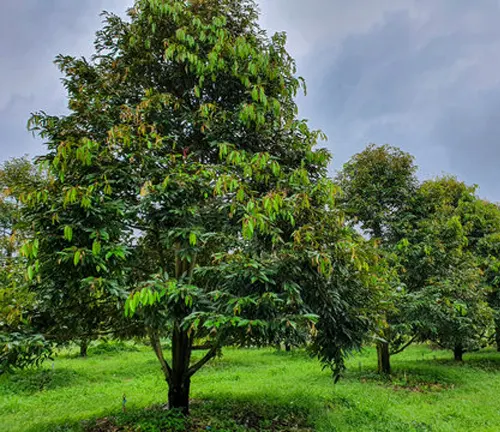
Native to Southeast Asia, particularly Malaysia, Indonesia, and Thailand, the Durian tree thrives in warm, humid climates and well-drained soils. Its fruits, colloquially known as the “king of fruits,” are revered for their unique, pungent aroma and rich, custard-like flesh.
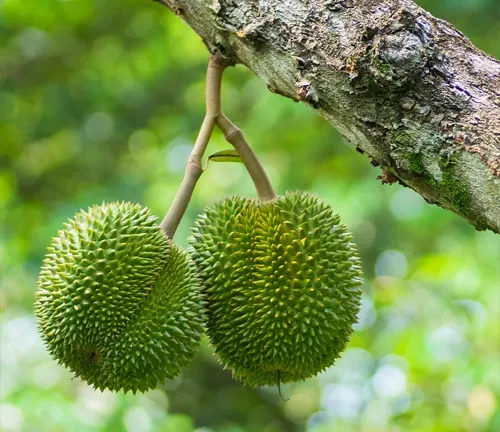
The durian’s outer husk is covered in thorn-like spikes, earning it a reputation as a forbidding and divisive delicacy. Despite its divisive nature, durians hold cultural significance in many Asian societies, where they are enjoyed both in their natural state and incorporated into various culinary creations. The Durian tree, with its imposing stature and distinctive fruit, stands as a symbol of tropical biodiversity and is deeply woven into the fabric of Southeast Asian culture.
| Characteristic | Description |
|---|---|
| Scientific Name | Durio |
| Family | Malvaceae |
| Height | Up to 40 meters |
| Foliage | Evergreen |
| Leaves | Large, glossy |
| Fruit Type | Drupes with a distinctive husk |
| Fruit Size | Varies, can be large, typically football-sized |
| Fruit Features | Spiky husk, strong odor, custard-like flesh |
| Native Regions | Southeast Asia (Malaysia, Indonesia, Thailand) |
| Climate | Tropical, warm, humid |
| Soil | Well-drained |
| Cultural Significance | Iconic in Southeast Asian societies |
| Common Nickname | King of Fruits |
Botanical Beauty of the Durian Tree
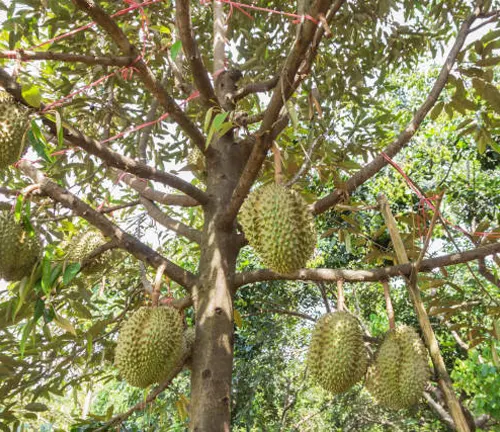
The Durian tree, scientifically classified as Durio, stands tall as a botanical marvel, captivating observers with its majestic presence. Belonging to the Malvaceae family, this evergreen giant boasts a towering stature, reaching up to 40 meters. Its large, glossy leaves contribute to its verdant elegance, creating a lush canopy that adds to the tree’s overall appeal. As a centerpiece in the tropical landscapes of Southeast Asia, the Durian tree’s botanical beauty is a testament to the region’s rich biodiversity.
Woodland Elegance
Beyond its botanical allure, the Durian tree exudes woodland elegance with its sturdy trunk and expansive branches. The wood of the Durian tree, known for its durability and resistance to decay, has found utility in various applications. Local craftsmen harness its strength for construction, creating furniture and tools that reflect the tree’s inherent grace. The Durian tree’s contribution to both the natural landscape and human craftsmanship underscores its significance in the ecosystems it inhabits.
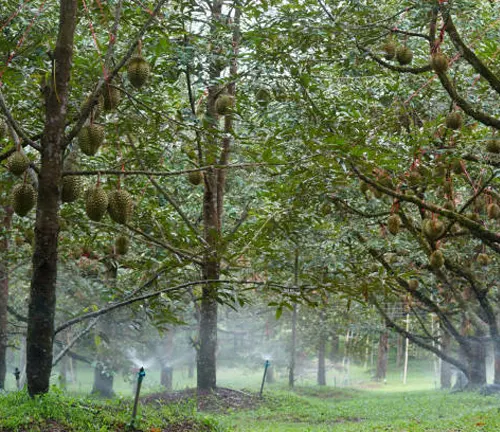
Ecological Importance
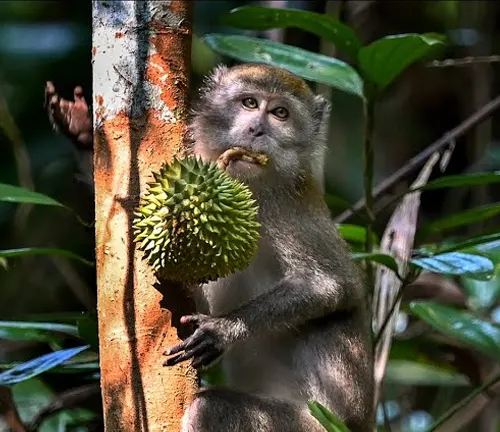

In the intricate web of Southeast Asian ecosystems, the Durian tree plays a vital role in maintaining ecological balance. Acting as a habitat for various species of flora and fauna, it fosters biodiversity within its canopy. Birds, insects, and other creatures find refuge in its branches, creating a harmonious relationship between the Durian tree and its surrounding environment. The tree’s ecological importance extends beyond its immediate surroundings, influencing the overall health of tropical ecosystems.
Cultivation and Conservation
Cultivating the Durian tree is an art that has been mastered over generations. Farmers in the native regions of Malaysia, Indonesia, and Thailand employ traditional methods to ensure a bountiful harvest of the distinctive durian fruits. However, as demand surges and environmental concerns grow, conservation efforts are gaining momentum. Balancing cultivation practices with sustainable measures has become crucial to preserving the Durian tree for future generations.
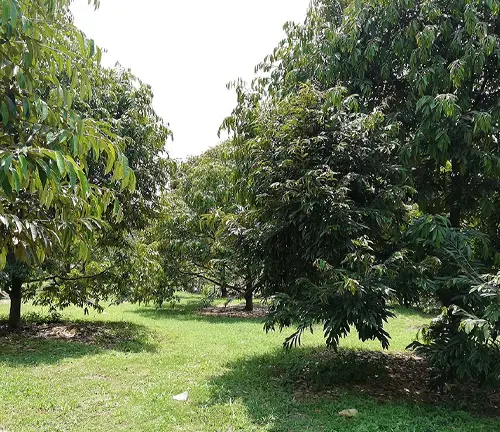
Fragrance
One cannot explore the allure of the Durian tree without delving into the infamous fragrance of its fruits. Often described as a blend of turpentine and onions, the durian’s scent is unmistakable and divisive. While some find it overpowering, others celebrate it as a sensory adventure. This unique fragrance has become synonymous with the Durian tree, adding a layer of intrigue to its already captivating presence in the tropical landscape.
Soil Stabilization
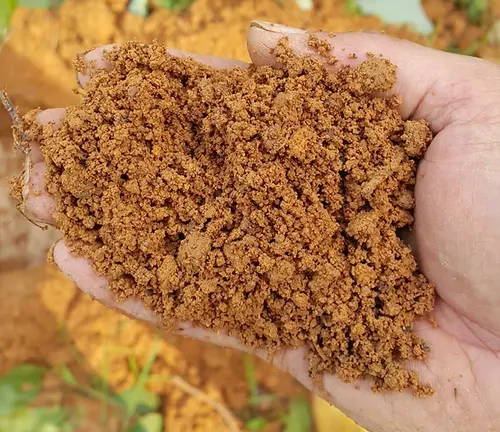
The Durian tree goes beyond bearing fruits and providing shelter; its roots contribute to soil stabilization. With an extensive root system, it helps prevent soil erosion in the tropical regions it inhabits. This function is crucial in maintaining the integrity of riverbanks and hillsides, showcasing the Durian tree’s role as a natural guardian of the land.
Common Uses

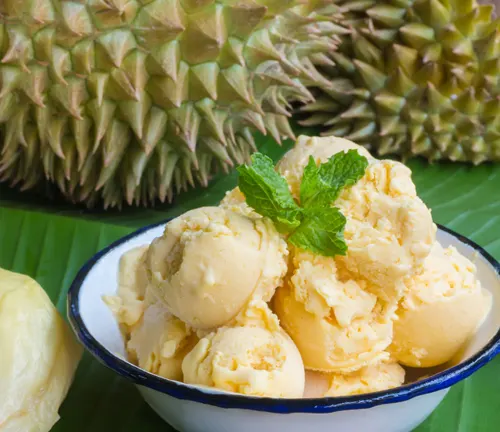
Communities in Southeast Asia have integrated the Durian tree into their daily lives, utilizing its various parts for different purposes. The durable wood finds applications in construction, while leaves are employed for thatching roofs. The tree’s versatility extends to its fruits, which are not only consumed fresh but also used in regional cuisine and processed into a variety of products.
Benefits
Beyond its cultural and ecological significance, the Durian tree offers numerous benefits to both the environment and human communities. As a source of timber, food, and traditional medicine, it sustains livelihoods and provides essential resources. Moreover, the tree’s presence in agroforestry systems contributes to sustainable land use, highlighting its potential to foster resilient ecosystems.
Different Species
Durio zibethinus
(Durian)
Commonly known as the durian, this species is the most well-known and widely cultivated. It produces the iconic durian fruit, celebrated for its distinctive aroma and rich, custard-like flesh.
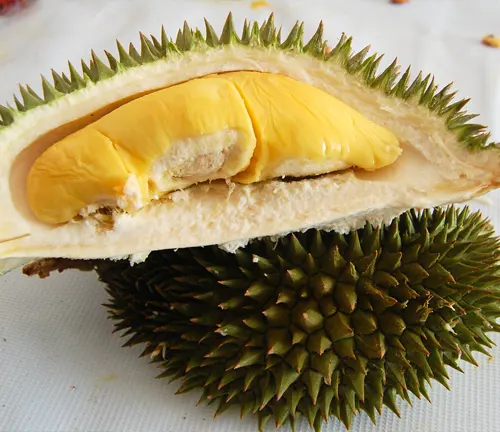
Durio graveolens
(Red-fleshed Durian)
This species is recognized for its red or orange-hued flesh. The flavor profile is often considered milder than the typical durian, making it a preferred choice for those who find the intense aroma and taste of traditional durians overpowering.
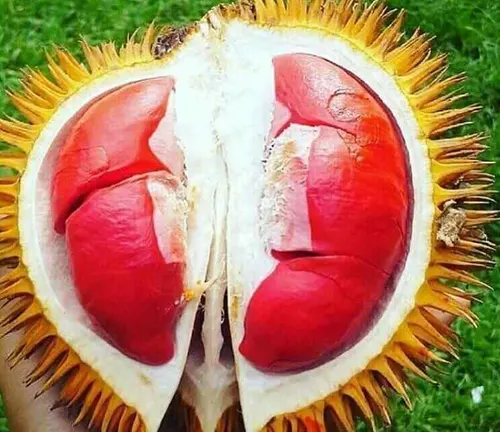
Durio dulcis
(Lahong)
Also known as Lahong or Red Durian, this species is native to Borneo. It is distinct for its smaller size and reddish-brown husk. The flesh is sweet with a hint of sourness, setting it apart from other durian varieties.

Durio kutejensis
(Kutej Durian)
Native to Borneo and Sumatra, the Kutej Durian is characterized by its small to medium-sized fruits. The flavor is less pungent compared to the common durian, and it is appreciated for its mild sweetness.

Durio oxleyanus
(Mauve Durian)
Found in the Malay Peninsula and Sumatra, this durian species is recognized for its mauve-colored flowers. The fruits are smaller than those of the common durian, and the taste is relatively mild.
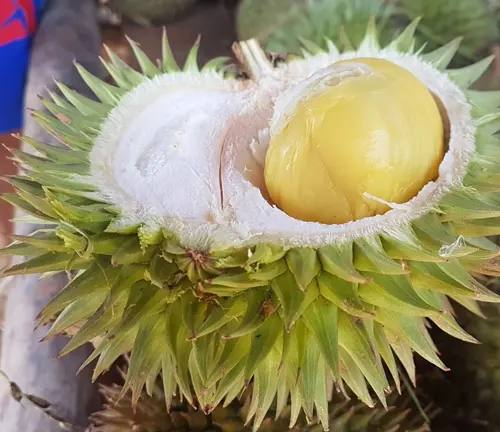
Durio testudinarum
(Turtle Durian)
Named for its thorn-covered husk resembling a turtle shell, this durian species is native to Borneo. The flesh is cream-colored, and the taste is a balance of sweetness and mildness.
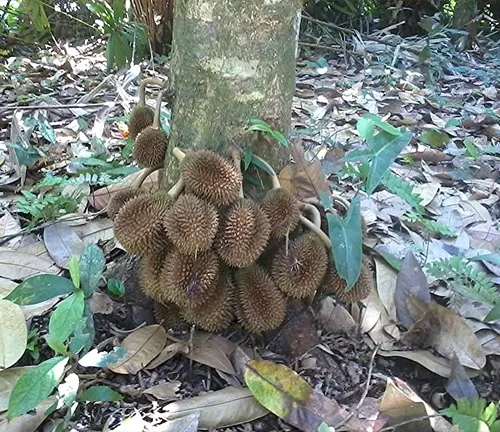
Durio macrantha
(Large Durian)
As the name suggests, this species produces larger fruits compared to the common durian. Native to Borneo, it is appreciated for its size and distinct flavor.
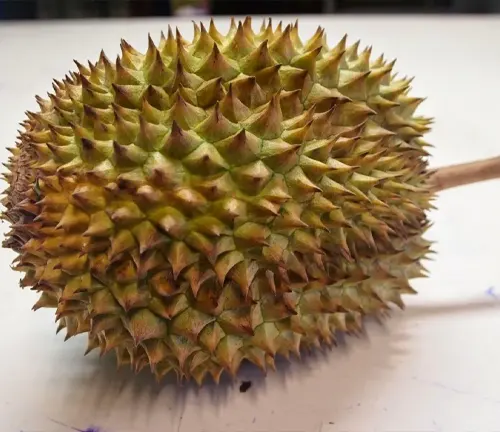
Durio kutejensis var. durianoides
(Malesian Durian)
This variant of Durio kutejensis is found in Malaysia and is known for its smaller fruits. It is considered less pungent than the common durian, with a subtle sweetness.
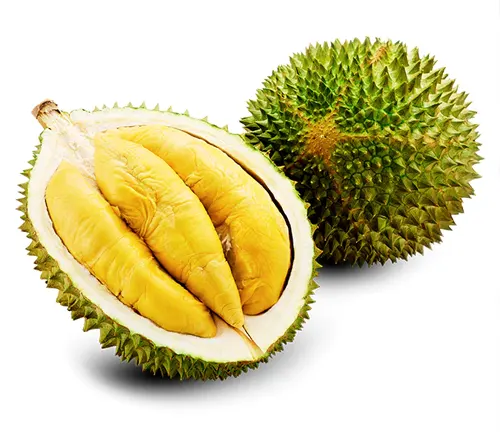
Frequently Asked Questions (FAQs)
1. What is the Durian tree, and where is it commonly found? The Durian tree, scientifically known as Durio, is an evergreen tree native to Southeast Asia, particularly in countries such as Malaysia, Indonesia, and Thailand. It is renowned for producing the distinctive and polarizing durian fruit.
2. What are the key features of the Durian tree? The Durian tree can reach heights of up to 40 meters and has large, glossy leaves. Its most recognizable feature is the durian fruit, known for its spiky husk and pungent aroma. The tree is valued for its wood, leaves, and ecological contributions.
3. How is the Durian tree cultivated? Cultivation of the Durian tree involves traditional farming methods, with an emphasis on well-drained soils and a warm, humid climate. Farmers in Southeast Asia carefully tend to these trees to ensure a bountiful harvest of durian fruits.
4. What is the significance of the durian fruit? The durian fruit is often referred to as the “king of fruits.” It holds cultural importance in Southeast Asia and is consumed both fresh and in various culinary preparations. Despite its unique and strong odor, durian enthusiasts appreciate its rich, custard-like flesh.
5. Are there different species of Durian trees? Yes, the genus Durio includes various species of durian trees, each with its own characteristics. Some notable species include Durio zibethinus (common durian), Durio graveolens (red-fleshed durian), and Durio kutejensis (Kutej durian).
6. What is the ecological role of the Durian tree? The Durian tree plays a crucial role in ecosystems by providing habitat for diverse flora and fauna. Its extensive root system contributes to soil stabilization, helping prevent erosion in tropical regions.
7. How is the Durian tree conserved? Conservation efforts for the Durian tree involve balancing cultivation practices with sustainable measures. Farmers and environmentalists work together to ensure the longevity of this iconic tree while addressing growing demands and environmental concerns.
8. Why is the durian fruit known for its fragrance? The durian fruit is infamous for its strong, distinctive odor. This fragrance, often described as a blend of turpentine and onions, is a result of various sulfur-containing compounds. While polarizing, it adds to the unique allure of the durian.
9. What are the common uses of the Durian tree? Communities in Southeast Asia utilize different parts of the Durian tree. The wood is valued for construction, leaves for thatching, and the fruit for consumption and processing into various products.
10. What are the health benefits associated with the Durian tree? The durian fruit is rich in nutrients, including vitamins, minerals, and fiber. It is believed to provide energy, support digestion, and offer various health benefits, although individual reactions to its consumption can vary.


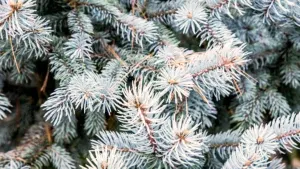
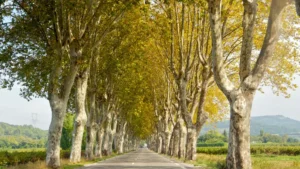

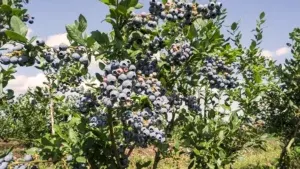
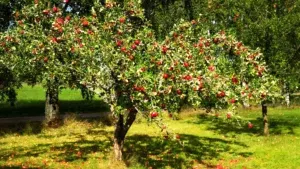

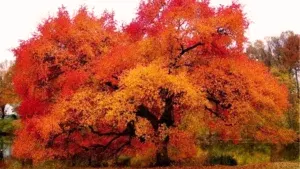
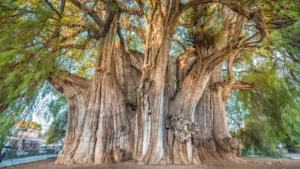
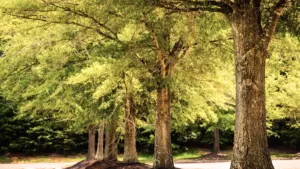
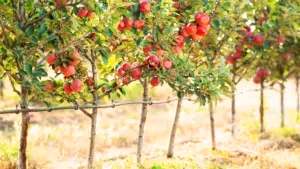

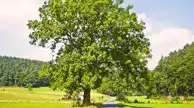
Laborous read as info is repeated in every paragraph using exact words and sentences.
Addison
March 16, 2024 1:13 pm